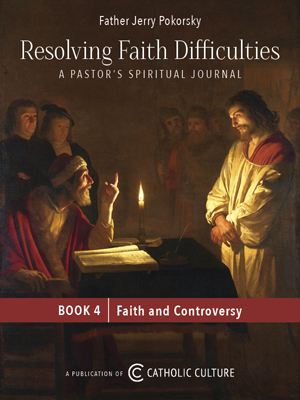Catholic Activity: Cooking for Christmas
Explanation of various traditions for the Vigil dinner on Christmas Eve.
DIRECTIONS
Since the Vigil of Christmas is a fast day [This day is no longer a fast day of the Church. -Ed.] it is only normal that the odor of cooking throughout the house all day long should accentuate our anticipation of the feast. Where is the victory where there is no fight? Even the children should be restrained from nibbling at all the delicacies reserved for Christmas. In our country this day of fast and abstinence is quite difficult. It is truly in the spirit of Advent, and it requires the patience of Job not to celebrate ahead of time. Popular custom has made Christmas Eve a feast day, since the majority of people tend to have parties, exchange presents, and carry on general feasting throughout the eve. Is it asking too much to request the penance of resisting over-anxiety? The anxiety should be there, and so should the spirit of joyful anticipation, but Mother Church still demands a final mortification before we taste of the heavenly joys of Christmas. Perhaps Christmas night would not fall so flat in many families if Christmas Eve were observed as a true vigil. It is our last preparatory offering to the Christ-Child, who accepted the humiliation of the stable at Bethlehem.
Culinary art has exceeded itself at this season. Since tomorrow is the feast, the greater portion of the cooking must be done in advance. Cooking for Christ and the Feast Day Cookbook should be consulted in detail. Swiss krabeli, Greek malachrino (spice cake), and German lebkuchen and stollen would delight the hearts of all. The very shape of stollen is supposed to represent the Christ Child, and the folds on top of the loaf swaddling clothes. Lebkuchen or life cake is an excellent reminder of the Bread of Life. Among English recipes are to be found everything from boar's head to plum pudding, with accent upon hot buttered rum and eggnog.
Since the vigil [wa]s a fast day, fish is in order. Whereas in Brittany the codfish takes the honors of the day, American custom associates piping hot oyster stew with Christmas Eve. Sponge cake or an Italian cream tart would make an excellent dessert, quickly prepared by the older girls. The Polish Christmas Eve supper, called the "wigilia," is perhaps the most complicated culinary celebration of the vigil. "In the homes of that country," the Feast Day Cook Book tells us,
stalks of grain are placed in the four corners of the dining room with a prayer for plenty in the years to come. Then bits of hay, symbolic of the manger in Bethlehem, are strewn beneath the tablecloth, which must be hand woven. The youngest child is set to watch for the first star of the evening, and when it appears he runs to tell the rest of the family. Then supper begins, as tradition has ordered it, with the breaking of the oplatek, a semi-transparent unleavened wafer made in an iron mold and stamped with scenes of the Nativity. Each one at the table breaks off a piece and eats it as a symbol of their unity in Christ. . . ." The soups are three in number, followed by three fish dishes accompanied by noodles, cabbage and dumplings. The desserts are also three, one of which is always a fruit compote with twelve dried fruits symbolic of the Twelve Apostles. At the end of the supper, carols are sung and presents are exchanged. The remainder of the food is often given to the animals in the hope that all living things may prosper by the food served in memory of Our Lord's first night on earth.In Austria on Christmas Eve, every house is filled with the aroma of fruchtbrot as it receives the visit of the anglöckler or bell-ringers, who go from place to place singing carols, sometimes two of their number impersonating Mary and Joseph seeking shelter at the inn. In Germany the Christmas observances go back to the start of Advent, when a wreath is hung, usually from the ceiling of the dining room, and to it a silver star is added each day, and each week a red candle. Also in advance is prepared the Christstollen (a long loaf of bread made with dried fruits and citron) as well as the lebkuchen and the marzipan, regarded as important holiday foods. On Christmas Eve the family gathers beneath the Advent wreath and sings carols. Then the Christmas tree is lighted and the gifts are distributed.
Activity Source: True Christmas Spirit by Rev. Edward J. Sutfin, Grail Publications, St. Meinrad, Indiana, 1955







